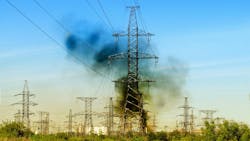Lesson Learned From Eaton and the Risk of Wildfires Spread by Transmission Lines
With the devastating wildfires near Los Angeles nearly 100% contained, Enverus Intelligence Research (EIR), a subsidiary of Enverus, a trusted energy-dedicated SaaS company that leverages generative AI across its solutions, has released a report analyzing wildfire risk levels across the U.S. transmission network and identifying the transmission owners most at risk.
EIR’s report draws from Enverus’ transmission line data sets and the expected annual loss from wildfires from the Federal Emergency Management Agency’s (FEMA) National Risk Index. The report identifies high-risk areas and transmission system owners most vulnerable to wildfire hazards, highlights the potential impact on grid reliability, and notes the unique inverse condemnation doctrine in California that amplifies a utility’s liability.
“The tragedy of the fires in Southern California, still burning today, cannot be overstated. The Eaton fire has highlighted a recurring issue in wildfire risk management: the importance of maintaining adequate vegetation clearance around transmission lines. While the cause of the fire remains under investigation, LIDAR data from 2016 already showed significant vegetation encroachment along certain segments of Southern California Edison’s Vincent-Hondo line, especially in mountainous areas. This underscores the need for ongoing investment in vegetation management, particularly in high-risk zones where dry and windy conditions can quickly turn sparks or arcing into devastating fires,” said Corianna Mah, analyst at EIR.
“Our report emphasizes that wildfire risk is not just a utility issue; it’s a shared challenge for policymakers, regulators and communities. By investing in resilience measures, incentivizing proactive risk management and updating regulations to account for evolving climate realities, we can reduce the impact of wildfires on both people and infrastructure,” Mah said.
“Our analysis using FEMA’s National Risk Index reveals that California, Texas, Florida and parts of the Carolinas have the highest concentration of transmission lines exposed to extreme wildfire risk. Nearly 50% of transmission lines across the Lower 48 are in high-risk categories,” Mah said.
Key takeaways from the report:
- California poses one of the highest risks for transmission line exposure to wildfires, driven by its large population, valuable buildings and properties. Its strict inverse condemnation laws are unique and amplify utilities’ liability to wildfire, even in cases where they are not negligent.
- Climate, aging infrastructure, population factors and wildfire activity patterns make West Texas, Florida and the Carolinas most vulnerable to wildfire risk. Across the U.S., nearly 50% of transmission lines are in high-risk categories.
- Vegetation encroachment on Southern California Edison’s (EIX) Vincent-Hondo line may have played a role in the ongoing Eaton fire. The frequent reports of power line-initiated wildfires suggest that EIX is not the only utility facing this challenge during an era of heightened wildfire risk.
